 |
|||
|
Page Title:
Ordnance Output Logic to Armament/Ordnance Input Logic |
|
||
| ||||||||||
|
|  MIL-D-81347C(AS)
(4)
The OOL shall be comprised of redundant logic sections
each operating on one-half of the computer output word. No launch action shall be performed unless
both logic sections agree. In addition. no single error, either logic malfunction or computer error
(i. e. , one bit), shall cause an erroneous launch operation.
The OOL shall terminate SUS Launch Commands after
(5)
130 10% milliseconds and SLT Select and Launch Commands after 260 10% milliseconds.
(6) The OOL shall not accept a command from the
computer
(i. e., the OOL shall not raise the External Function Request) during the period the OOL is
exercising a
Launch Command or within 130 10% milliseconds after receipt of a Select Command (door,
buoy
life or depth, or SLT select), or within 1 microsecond through 1 millisecond after receipt of
an AOIL
Interrogate Command.
(7) The OOL shall be self-initializing after any power interrup-
tion (i. e. , the OOL shall insure that no output command shall be high for more than 1 millisecond due
to the random setting of flip-flops caused by the power interruption).
(8) Removal of the OOL subunit shall cause the Aircraft Ord-
nance System to revert to a reset state (i. e. , no SUS selected, all doors closed, and no Launch Com-
mands).
The OOL shall detect and transmit to the AOIL the errors
(9)
described in 3.5.2.4.5.2 (9).
3.5.2.4.5.4
Interface Requirements
Word Formats - The OOL Word Formats are shown in Figures
3.5.2.4.5.4.1
84 through 88.
Signal Characteristics - Unless otherwise noted, signal levels
3.5.2.4.5.4.2
external to Logic Unit 2 are defined as follows:
Logical "0" = +4 1 volts
Logical "1" = 0.0 +0.5 -0.0 volts
Maintenance Control Panel Subunit to Ordnance Output Logic -
3.5.2.4.5.4.3
Communications between the computer and the OOL shall be via the MCPL and in accordance with
Appendix I and 3.5,2.4.6. The MCPL shall provide the input amplifiers for External Function and
data bits O through 29. Data shall be available to the OOL. Input amplifiers are specified in
Appendix II.
Ordnance Output Logic to Maintenance Control Panel Subunit -
3.5.2.4.5.4.4
The OOL shall provide to the MCPL the input control and data lines for monitoring.
3.5.2.4.5.4.5
Ordnance Output Logic to Armament/Ordnance Input Logic
Error Signals - The OOL shall be capable of detecting and trans-
3.5.2.4.5.4.5.1
mitting to the AOIL the three types of errors indicated in 3. 5.2.4.5.2 (9). In addition, an inhibit
signal shall be transferred from the OOL to the AOIL. The inhibit signal shall be a logical "1" during
the time the External Function Request is a logical "0". (See 3. 5.2.4.5.3 (6). )
The Type I error signal (indicating an input word structure is
improper (see 3. 5.2.4.5.2 (9) (a)) shall be a logical "1" for O. 5 microseconds (min. ): the
trailing edge of this pulse shall occur during the time the inhibit signal is a logical "1". Therefore,
data comparison for a Type I error shall be done during the time the External Function is a logical "l".
The Type II error signal (indicating the redundant status logic is
not in agreement (see 3. 5.2.4.5.2 (9) (b)) shall be a logical "1" for an indefinite length of time. Data
comparison of the Ordnance-Status registers shall be done continuously and the Type II error signal
shall be transmitted to the AOIL any time the registers do not agree.
152
|
|
Privacy Statement - Press Release - Copyright Information. - Contact Us |